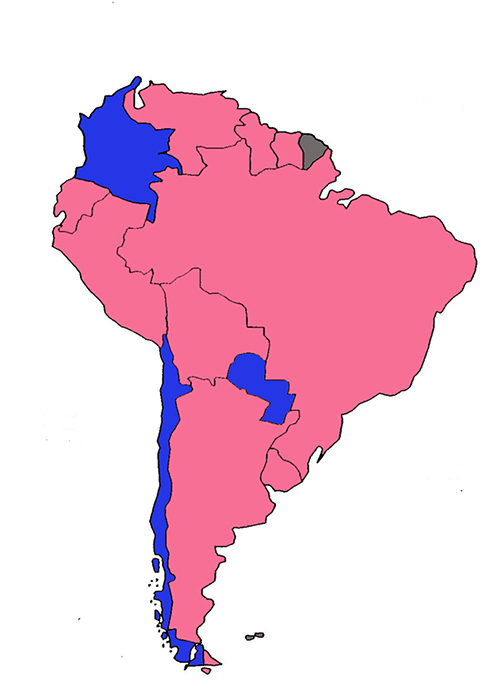Leaving Latin America, I want to comment on a phenomenon that seems to be sweeping this part of the world. It is the so called pink tide, the simultaneous occurrence of a left swing in the politics of the most countries on this continent. It is pink of course because bloody red is somehow appropriated by the communists, whereas the socialists can be safely painted in pink. Latin America has been under robust American control for many years, belonged to the immediate American sphere of interests. But especially in the most recent years, after the end of the Cold War, the situation here changed radically and one after another pieces of the domino fell as socialist or left-wing presidents won elections.
There are 12 independent countries in South America. Today there are left-wing governments in 9 of them, and Michelle Bachelet just won the first round in presidential election in Chile and is likely to win the second, making it 10 out of 12.
This is how it looks:

Left-wing governments (9*):
Venezuela – president Maduro, who followed of course the unforgettable and polarising Hugo Chavez, in power from 1999
Brazil – president Dilma Rousseff, the heir to president Lula – from 2003
Bolivia – president Evo Morales from 2006
Uruguay – president José Mujica from 2010, his predecessor from 2005
Argentina – president Cristina Fernández Kirchner, her husband Nestor preceded her from 2003
Peru – president Ollanta from 2011
Ecuador – president Rafael Correa from 2007
Guyana – president Ramotar, his left-leaning party in power from 1992
Suriname – president Bouterse from a Social-Democrat bloc
Right-wing governments (3*):
Colombia – president Santos from 2010
Paraguay – président Cartes from 15 August 2013 belongs to a right-wing party Colorado; his predecessor was left-wing
Chile – imminently will change the president, current president is from the right, but his predecessor was Socialist Michelle Bachelet, who is also likely to win the second round in December
Left-wing governments are in power also in a number of Central American countries, such as Nicaragua and Dominican Republic, although the political spectrum is more complex there. (Cuba of course is still ruled by the Castros, but cannot be considered to be a part of the pink tide.)
What explains this phenomenon?
I think in the first place as the world is globalising and the instant communication is connecting it in ways unthinkable before, the nature of propaganda is changing entirely. It has become increasingly difficult or impossible to hide the past crimes or to persuade the population of a point of view that is right against its own interests. As the military dictatorships fell all around the continent and their crimes became widely known, the voters have naturally drifted in the opposite direction, to the left. Simultaneously the indigenous populations have become more and more self-aware, aware and proud of their history and heritage. I wrote on this blog how in Cusco, Peru all the street names have been changed from colonial Spanish to Inca; how the Chilean students enthusiastically barricade themselves inside the university buildings to demand free education; how the indigenous Bolivian president proudly demonstrated the illegal coca leaf from the UN tribune, insisting that it is a part of the cultural heritage of the Andes. Left-wing tendencies occur in all sphere of life. Patriarchal and ultraconservative countries suddenly elect women to the presidency: Brazil, Argentina and soon Chile are led by women. Same countries allow same-sex unions, today they are a reality in Argentina, Uruguay and parts of Mexico.
Of course left-wing tendencies manifest themselves differently from country to country and often lead to specific problems. Everyone in Argentina seems to assume the corrupt nature of Cristina’s regime and her currency system which I described earlier is quite absurd. In Venezuela the regime of Maduro-Chavez is also at times bordering on the extreme. Brazil has serious problems which were demonstrated by recent mass demonstrations.
And yet South America is the one continent where today we have the most lively and thriving democracies on Earth, where the societies are transforming with lightning speed. Needless to say, I fell in love with South America.